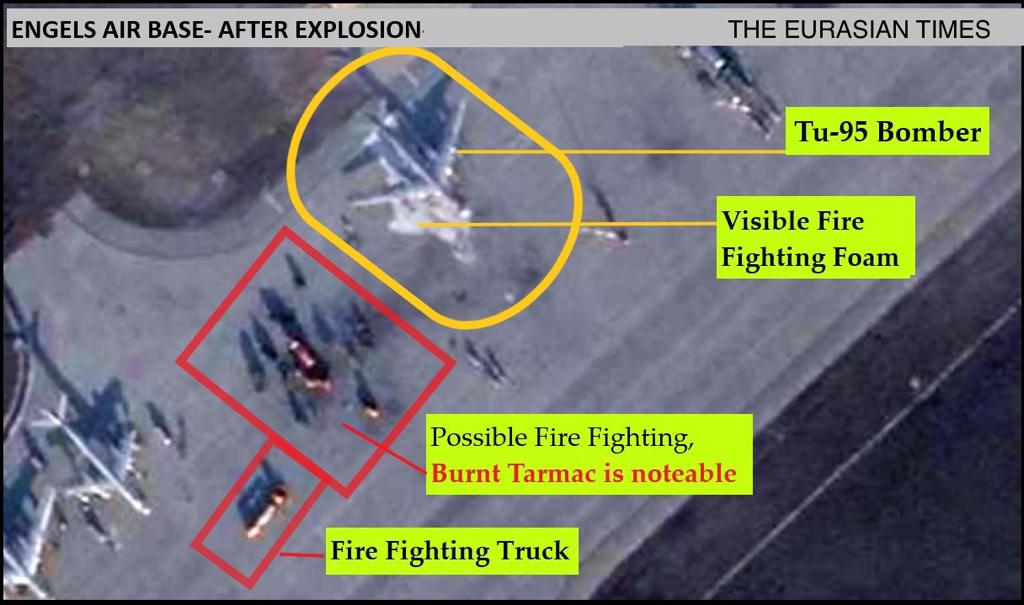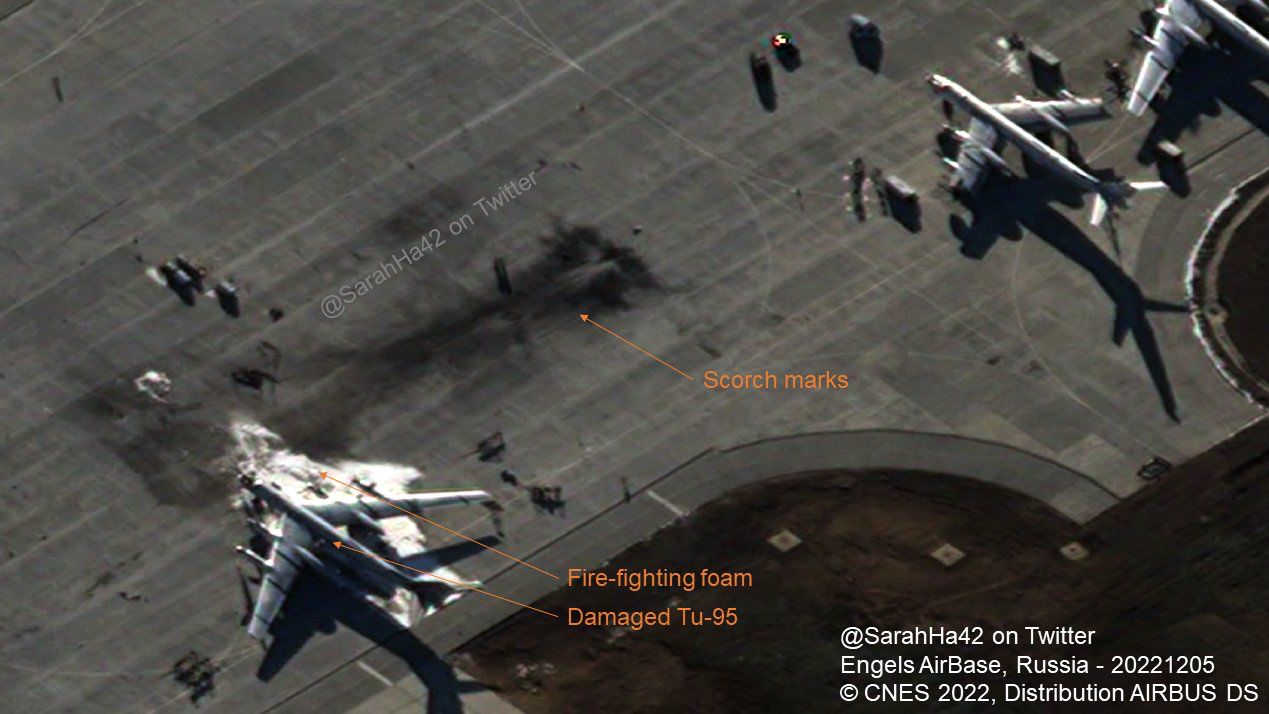On December 5, Russia’s Engels-2 Air Force Base, situated deep inside the Russian territory, came under attack by Ukrainian drones. While the damage could not be ascertained initially, new satellite imagery shows the Russian Tu-95 bomber has taken a significant hit.
In the aftermath of the attack, the Russian Ministry of Defense (MoD) stated that it was carried out using modified Soviet-era Unmanned Aerial Vehicles (UAVs). Even though it did not specify which drone was responsible for the strike, military specialists quickly deduced that it was most likely the Tu-141 Strizh.
In a new development, satellite imagery of the Engels-2 Air Base located in the Saratov region shows that at least one Tu-95 strategic bomber of the Russian Aerospace Force caught fire and suffered significant damage.
The bombers were recently deployed to the Engels Air Force Base, triggering concerns about a fresh air raid on Kyiv.

As per the satellite imagery (below) obtained by EurAsian Times, a Tu-95MS strategic bomber can be seen covered in fire-fighting foam used to cool the fire and coat the fuel to prevent its contact with oxygen.

Further, next to the heavily damaged aircraft are marks of impact hinting at an explosion and a somewhat incinerated tarmac. Not just that, a fire-fighting truck is also visible in the satellite imagery in the vicinity of the bomber.
The loss of Tu-95 from active service could be a big blow for Russia as this nuclear bomber, the mainstay of its bomber fleet, has never been hit or destroyed in combat. Even though the aircraft wasn’t completely damaged, it would now head to the repair hangars before it gets ready for action, probably in a year.
#Russia: The aftermath of the recent Ukrainian long-range strike against Engels-2 Air Base – a Tu-95MS strategic bomber can be seen covered in fire-fighting foam next to an impact and scotch mark. pic.twitter.com/bbyIRJEnFt
— ?? Ukraine Weapons Tracker (@UAWeapons) December 6, 2022
Further, the unprecedented attack has dealt a double blow to the Russians as this is the first time the Ukrainians have carried out a long-range strike on Russia, a capability unknown until now.
The locations that were struck- Engels-2 and Dyagilevo Air Force Bases – are closer to the Russian capital than the borders with Ukraine.
In addition, according to Ukrainian media, the Russian Military had only 60 Tu-95 Bombers when it launched the invasion in February 2022. Along with the Tu-160, the Tu-95 long-range strategic bomber is the backbone of the Russian Aerospace Forces (RuAF).
Through the course of this war which is now into its tenth month, Russia has lost several of its cutting-edge and expensive combat jets. The loss of a bomber stationed deep inside the Russian depth would cause more heartburn than a fighter jet shot down over the Ukrainian airspace.
A Turning Point?
Few airplanes stand out as much as the huge Tupolev Tu-95 “Bear,” a four-engine Russian strategic bomber and maritime patrol plane with a large unicorn-like refueling probe.
The Tu-95 is still in service after more than sixty years because few aircraft can travel long distances while carrying a heavy payload. The Tu-95 is one of the fastest existing propeller planes, capable of reaching speeds of over 500 miles per hour.
Over fifty to sixty Tu-95MS aircraft are still in service today to operate as cruise-missile carriers capable of firing Kh-55 missiles.
They’ve been modified to carry sixteen cruise missiles each and modern navigation/targeting systems. The Kh-55 is available in various conventional and nuclear variants, ranging from three thousand kilometers to three hundred kilometers.

The Tu-95MSM variant can also launch the Kh-101 and nuclear Kh-102 stealth cruise missiles, which fly at low altitudes and have a low radar cross-section. To keep its aircraft out of the range of Ukrainian air defense systems, Russia has sent bombers armed with long-range cruise missiles to attack Ukrainian positions outside Ukrainian airspace.
This is why the mobilization of bombers at the Engels Air Force Base caused widespread panic among Ukrainians and led to the unprecedented drone attack. However, this is not the first time the Russian Bomber has caught fire and incurred massive damage, noted Ukraine’s local media.
Several years ago, in 2013, the Tu-95MS, board number 21 “Red,” caught fire due to a short circuit caused by poor electrical network installation during repairs. The plane was not totally on fire then, and the bomber did not appear to have been substantially damaged on the surface.
However, it was later revealed that the flames destroyed the aircraft, and the Tu-95MS fragments were abandoned since their condition was irreparable. Three years later, another Tu-95 bomber caught fire and was disbanded from service.
This time, the engine of an unidentified Tu-95MS caught fire at Russia’s Far East “Ukrainka” Air Base in November 2016. Despite the appearance of a more catastrophic fire than the last known incident, some reports claimed that the aircraft was later repaired.
In both incidents, the actual damage could not be assessed by the appearance of the damaged aircraft alone. However, irrespective of whether the bomber aircraft was irreparably damaged, Russia has launched another massive missile strike on Ukraine that is only expected to intensify.
- Contact the author at sakshi.tiwari9555 (at) gmail.com
- Follow EurAsian Times on Google News




